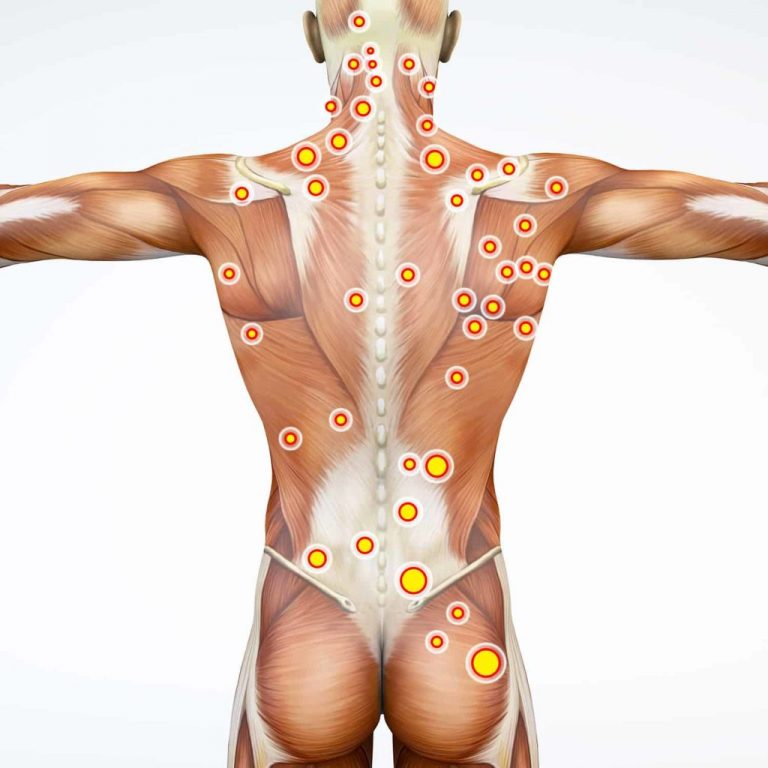Stress, lack of exercise, computer work and headaches? It may turn out that the first three factors are the cause of the last problem. Damage to the myofascial system can create trigger points. Their accumulation is called myofascial syndrome, which has completely different non-obvious symptoms. Which one? We will explain below.
Myofascial system – what is it?
The fascia is a membrane that covers the fibrous tissue of a muscle and supports the individual elements of the body so that they form a coherent, compact whole. This includes all collagen fibers, including but not limited to joint capsules, tendons, tendons, and ligaments.
Since physiotherapists cannot take care of the muscles bypassing the fascia in their work, they use a term that more closely matches their field of activity – therefore, instead of the muscular system, we often hear about the myofascial system. In contrast, chronic disorders of its functioning, including long-term problems associated with trigger points, are called myofascial syndrome.

A few words about trigger points
These are places that are especially sensitive primarily to pressure, but also stretch and contract, most often formed in the muscle region of the abdomen or fascia. Some types can also cause radiation pain. There are three types of changes of this type:
- active trigger points – sudden and unexpected pain, radiant; tingling, numbness, itching, burning, or similar sensations; sometimes it can also cause pain projected to other, sometimes distant areas of the body;
- hidden trigger points – limit mobility and weaken muscle strength, may even affect body posture, but are not felt as pain;
- embryonic trigger points – similar to active points, there is severe pain, but it does not radiate or project other areas.
You can learn more about trigger points in our article. Types of trigger points and their diagnostics.

Myofascial pain – causes
On Until now, experts have not been able to unequivocally answer the question of the direct causes of myofascial syndrome. Of course, he likes better:
- congenital malformations of the skeletal system,
- acquired defects in posture
- stress,
- tired,
- inactivity or excessive muscle overload.
It can be an effect of trauma or complication of inflammation, but with factors that can have an effect on the onset of myofascial pain also includes a sedentary lifestyle, obesity, nutritional deficiencies and even hormonal imbalances, alcohol or smoking.
Do you want to lose extra weight? You can buy fat burners at this link https://buysteroidsgroup.net/ to help you do so.
How to recognize myofascial pain?
palpation. However, let’s start with how to recognize myofascial pain. Typical symptoms that a specialist will look for:
-
- trigger points and their sensitivity to tapping or stimulation,
- pain predicted after trigger point stimulation
increasing muscle tone,
- muscle weakness,
- painful contraction and muscle strain.
In addition to myofascial pain, additional symptoms may appear, for example:
- headaches,
- vasoconstriction,
- changes in heart rate,
- disorders of the digestive tract (heartburn, indigestion, indigestion)
- skin changes,
- lacrimation, conjunctival erythema,
- goosebumps.
Myofascial syndrome – treatment
When a specialist identifies our diseases, it is very important to recognize the factors that caused myofascial pain and eliminate them – it is necessary that the effects of therapy are permanent.
For the treatment of myofascial syndrome, the best results are usually obtained by a combination of several methods: exercise, pharmacotherapy and physiotherapy. Specific exercises to help combat this problem will be shown to the patient by a specialist during the consultation.
Physical therapy may instead include:
- manual techniques (e.g. ischemic compression, positional release),
- dry point, i.e. piercing a thin needle at the trigger point,
- laser therapy,
- Tekar therapy.
The high energy laser allows energy deep into the muscle tissue, making it more efficient. It helps relieve pain and relax muscles, and supports regeneration. Thus, it brings relief to the patient almost immediately. The iLUX laser even has a pre-programmed trigger point mode, making it much easier for therapist with myofascial syndrome to work effectively.
The second type of treatment that speeds up the treatment is therapy with the Dr. Tekar apparatus. High frequency radio waves quickly deliver large amounts of energy to the site identified as a source of myofascial pain, allowing the body to heal faster and reduce soreness.
